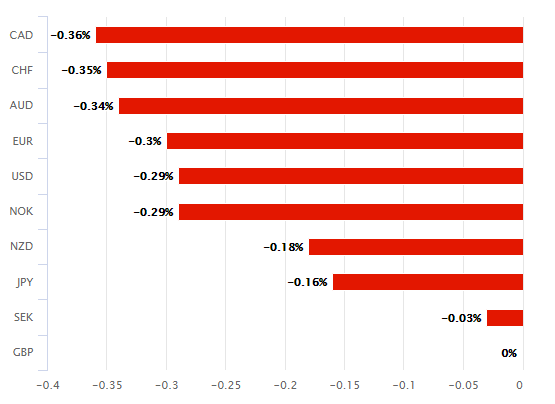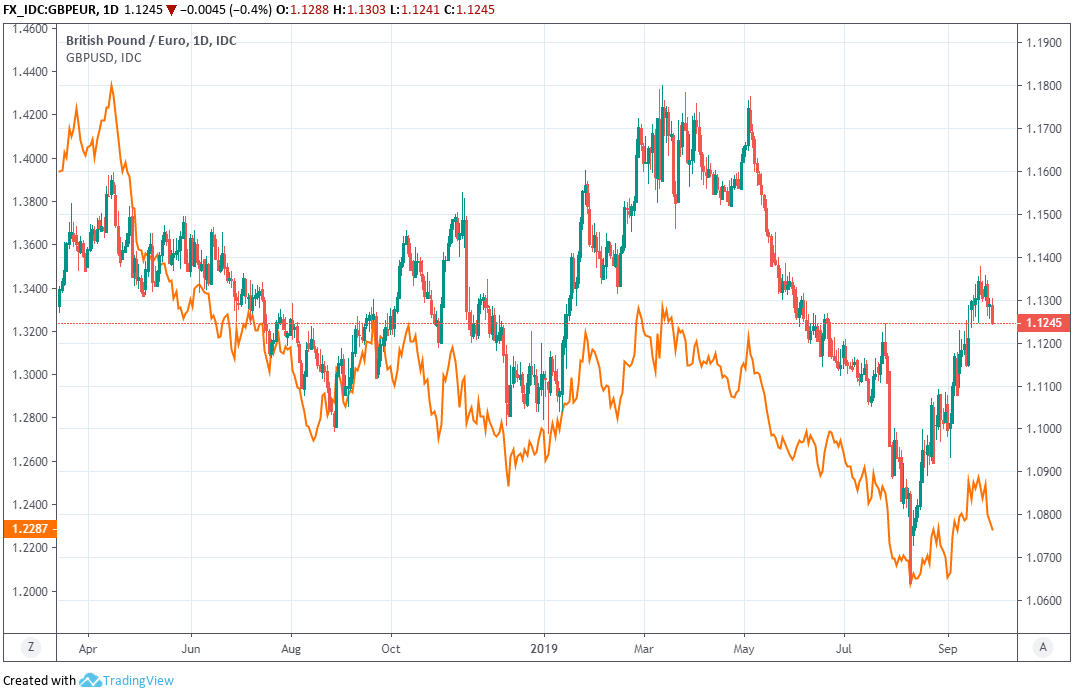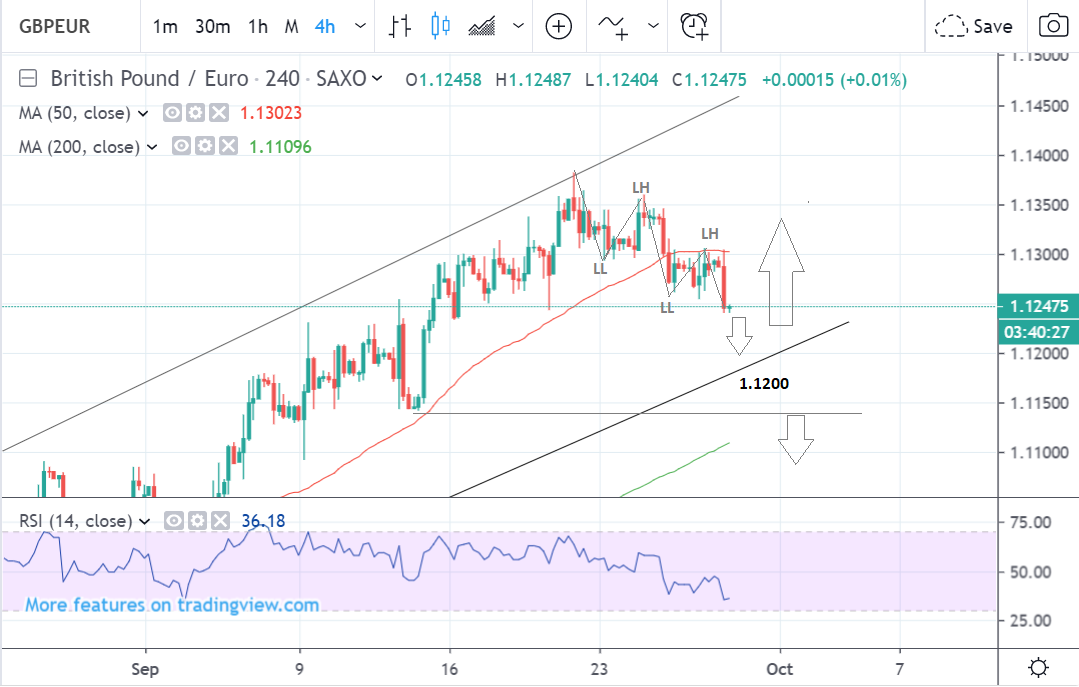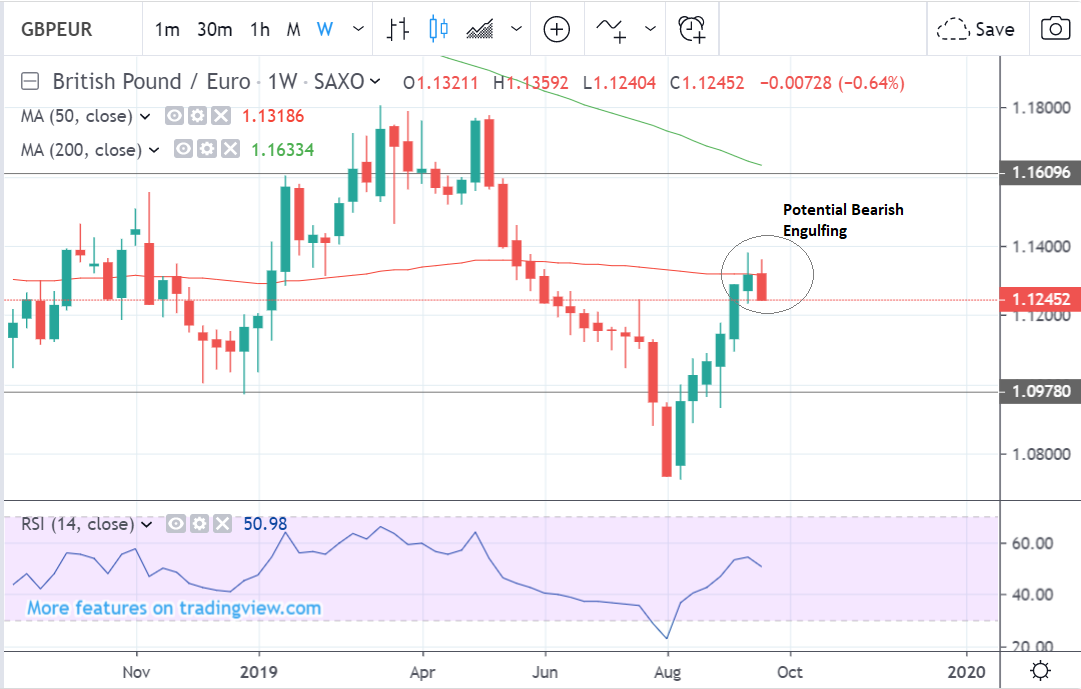Pound Sterling in Retreat after Bank of England's Saunders says Rate Cut in the Cards
- Written by: James Skinner

Images© Bank of England
- GBP slides after BoE speaker suggests rate cut is now in the cards.
- BoE frets over economic 'slack' amid trade war, Brexit uncertainty.
- Says persistent uncertainty to hurt, even without a 'no deal' Brexit.
- 'No deal' fears are resurfacing and tipped by some to weigh on GBP.
- Pound Sterling Live techs suggest GBP/EUR trend still salvageable.
- But GBP/USD rate has reached a make-or-break point on the charts.
The Pound was in retreat Friday after a policymaker at the Bank of England (BoE) said in a speech that interest rates might need to be cut in the months ahead even if a 'no deal' Brexit is avoided, in contrast to the bank's September claim that rates will still need to rise over the coming years.
Michael Saunders, an external member of the Monetary Policy Committee that sets interest rates at the Bank of England, said Friday that an ongoing global slowdown and "persistently high uncertainty" over the likely outcome of the Brexit saga are now weighing heavily on the UK economy and that it might soon be appropriate to cut borrowing costs for companies and households as a result.
"The economy could follow very different paths depending on Brexit developments. But in my view, even assuming that the UK avoids a no-deal Brexit, persistently high Brexit uncertainties seem likely to continue to depress UK growth below potential for some time, especially if global growth remains disappointing. In such a scenario – not a no-deal Brexit, but persistently high uncertainty – it probably will be appropriate to maintain an expansionary monetary policy stance and perhaps to loosen further," Saunders says.
Saunders' comments, made to the Barnsley & Rotherham Chamber of Commerce & Institute of Chartered Accountants, come barely more than a week after the BoE said jobs growth is "softening" and that there's is now "a margin of excess supply" in the economy or so-called 'slack'. But the bank hinted strongly at the time that it doesn't intend to follow the European Central Bank (ECB), Federal Reserve (Fed) and others in cutting rates up ahead.

Above: Pound Sterling performance Vs major rivals Friday. Source: Pound Sterling Live.
Changes in rates are normally only made in response to movements in inflation, which is sensitive to growth, but impact currencies because of the push and pull influence they have over capital flows. Those flows tend to move in the direction of the most advantageous or improving returns, with a threat of lower rates normally seeing investors driven out of and deterred away from a currency.
"The level of uncertainty facing UK businesses and consumers has been relatively high since the EU referendum. But these uncertainties have risen again in recent months, especially regarding Brexit," Saunders says, in his Friday speech. "With persistently high Brexit uncertainties and softer global growth, the UK economy has weakened markedly in recent quarters, opening up a modest amount of spare capacity."
Central banks the world over have cut rates and set out to support their economies with other measures this year in response to a slowdown in international trade, manufacturing and overall economic growth brought on by the trade war between the U.S. and China. The tariff fight has arguably done more damage to Germany and the Eurozone than it has either of the protagonists, with consequences for others connected to those economies.
But the BoE left Bank Rate unchanged at 0.75% this month following a unanimous decision, but reiterated that rates will need to rise in the event that an orderly exit from the EU is eventually achieved, because that would lead to what it forecasts will be a "significant margin of excess demand" that subsequently lifts inflation above the 2% target. It forecasts third-quarter growth of just 0.2% will follow the -0.2% contraction seen in the prior period and that inflation will run below the 2% target "in the near term".

Above: Pound-to-Euro rate at daily intervals, alongside Pound-to-Dollar rate (orange line, left axis).
"The global downturn won't leave Britain's economy unscathed," says Marc-Andre Fongern, a strategist at MAF Global Forex. "Nevertheless, the UK currency remains a hostage to political uncertainty for the time being."
In other circumstances the BoE's outlook might have been enough to make the bank less certain of any perceived requirement for higher rates over the coming years. However, the BoE is being constrained in its actions by other factors at the moment, most notably what might happen to the Pound in the event that it abandons the pledge, or claim, to be looking to raise interest rates.
With that commitment helping to support a weakened Sterling, getting rid of it could risk an inflationary spiral in UK exchange rates that would raise import prices and could end up driving inflation above the target. A 'no deal' Brexit would also produce such an inflationary spiral.
"In making the case for a cut now it conforms to the belief in many in the market that the Bank is barking up the wrong tree with its slight tightening bias in its forward guidance. On Brexit – there’s a lot of noise of course and all the chatter is about MPs’ use of language and how could Boris possibly still take the UK out of the EU by October 31st without a deal. The fact is he can and he intends to," says Mark Wilson, chief market analyst at Markets.com. "There is some serious risk that GBP declines from here into the middle of October on the uncertainty and heightened risk of no deal."

Above: Pound-to-Euro rate at 4-hour intervals, with technical indicators displayed.
There's still extreme uncertainty over the likely outcome of the Brexit saga, and concerns about the prospect of a 'no deal' Brexit have resurfaced again this week. Former PM John Major expressed concerns about Boris Johnson's Brexit strategy Thursday, claiming he could circumvent the so-called Benn Bill passed through parliament this month with the help of an apparently partisan Speaker of the House of Commons and 21 now-former Conservative MPs.
Fears of a 'no deal' Brexit are rising and warnings of further losses for Sterling are stacking up but Pound Sterling Live technical analyst Joaquin Monfort, who studies trends and momentum on the charts rather than developments at the BoE and statements in parliament, says that for now at least the August-September uptrend in the Pound-to-Euro rate is still salvageable.
"From a technical perspective, the sell-off in GBP/EUR remains corrective. There is still insufficient evidence to suggest a full-scale reversal from the established short-term uptrend which began in August, to a new downtrend. As the chart below shows, the pair continues to trade within the confines of a very clear trend-channel and as long as this is the case there is still a strong possibility it could resume its uptrend," Montfort says. "The sell-off in GBP/USD has reached a key line in the sand at the 50-day moving-average and 50% fibonacci retracement of the previous rally. This could be a level at which it either reverses of breaks down further - ie 'make or break' level."
Montfort is watching to see if a "trend-channel" for the Pound-to-Euro rate and a support level at 1.12 will hold over the coming days. He says that if they do, then the fledgling uptrend that began in August could go on for a while yet, although the Pound-to-Dollar rate is a different story because the British currency is now at a make-or-break level against the Dollar as far as the technical trend goes.

Above: Pound-to-Euro rate shown at weekly intervals.
Time to move your money? Get 3-5% more currency than your bank would offer by using the services of foreign exchange specialists at RationalFX. A specialist broker can deliver you an exchange rate closer to the real market rate, thereby saving you substantial quantities of currency. Find out more here.
* Advertisement




